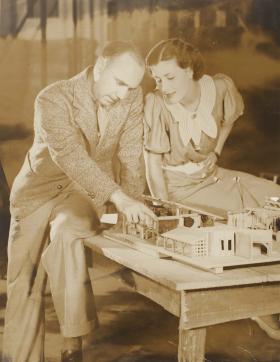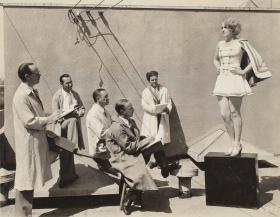In 1940 when my father, Eric Thompson, was an art director on Charles Chauvel’s film Forty Thousand Horsemen, the production company built a replica of the famous garrison village of El Arish in the Cronulla sand dunes. I remember his story about a homeless man who was sleeping on the beach at the time and woke to the sight of a minaret, part of the set for the Battle of Beersheba. The man swore he would never drink again. Photographs of the Horsemen set, along with other reminders of my father’s life in film — which began at Hollywood’s Metro Goldwyn Mayer studios in the 1920s — are held in the Mitchell Library.
Eric Thompson was born on 9 June 1901 at Drummoyne, Sydney, and educated at Sydney Grammar School. His love of drawing was evident at an early age and on leaving school he found employment as a cartoonist on the Cumberland Argus and Fruitgrowers’ Advocate, a Parramatta-based newspaper.
Intent on studying architecture, he enrolled at Sydney Technical College where he met T. Eric Cooper, five years his senior. Over the next few years, the two aspiring architects formed a close association. In early 1926, they embarked on SS Manuka to Noumea, considered an exotic destination at the time. In June that year, watercolour and pencil drawings of buildings they encountered on the trip were included in the Institute of Architects’ Annual Sydney Exhibition.
Later that year, having returned to Sydney, both artists were represented in a show at Manufacturers House on Sydney’s O’Connell Street. According to a Sydney Morning Herald art critic:
"Mr Thompson’s pencil drawing of Fairholme at Parramatta is one of the outstanding exhibits: while his many pen and ink sketches of Noumean scenes are faithfully done, and testify to an excellent command of line."
The colonial home Fairholme — once owned by National Trust founder Annie Wyatt — had ignited Eric’s lifelong interest in Australia’s heritage buildings. Articled to leading architectural firm Morrow and Gordon, and later to Joseland and Gilling, Eric received the Howard Joseland Prize for an outstanding young architect. Today, architectural drawings by Eric Thompson held in the Mitchell Library include the National Mutual building in Pitt Street and the Grace building in York Street.
In February 1927, the young adventurer set sail for the US, visiting New York and later Philadelphia, where he joined a firm of architects and frequented the T-Square Club, which held exhibitions of architects’ work.
An exhibition of Eric’s drawings brought him to the attention of MGM’s Cedric Gibbons, who in 1927 invited him to take up a position as an art director at the company. As head of the art department at MGM from 1925 until 1956, Gibbons supervised a large staff, with his name appearing on more than 1500 movies as art director (his contract stipulated that his name was to appear on every release). His films had a lavish Art Deco style with his signature ‘Big White Set’ seen in such classics as Dinner at Eight (1933). A founding member of the Los Angeles Academy of Motion Pictures Arts and Sciences, Cedric Gibbons is credited with designing the Oscar statue itself.
It was the Golden Age of Hollywood and the young Australian art director would have crossed paths with some of the great stars of the day such as Ginger Rogers, Joan Crawford and Greta Garbo. He worked with many famous filmmakers including Irving Thalberg, Ben Hecht, and Walter Wanger.
During his 10 years at MGM, Eric worked on classics such as Ernst Lubitsch’s The Merry Widow (an Academy Award winner), and MGM’s first sound film, The Last of Mrs Cheyney. Reflecting on his time at MGM, he told Film Monthly in 1949:
"I have often been asked the qualifications for an Art Director. Architectural knowledge of all periods and some engineering knowledge are essential. But to this you can add theatrical licence and lashings of imagination for you may be called upon to design anything from a hat shop to the interior of a submarine.|
When Walter Wanger left MGM to begin independent production, he asked Thompson to join his crew. With Wanger, he made six films including The Trail of the Lonesome Pine, now regarded as a screen classic.
The Australian years
Returning to Australia in 1937, Eric Thompson joined Cinesound, then based at Bondi Junction. While working there he met and married publicist and author Nancy Gurr, a member of one of Australia’s literary families (her father was novelist Thomas Stuart Gurr and her brothers Tom and Rodney had high-profile careers in journalism and film).
A trailblazer and feminist, Nancy was the sole woman in the Cinesound decision-making team. It was later acknowledged that thanks to her expertise and flair for promotion, many young actresses made the transition from obscurity to stardom (for more on Nancy’s career see Andrée Wright, Brilliant Careers: Women in Australian Cinema, 1986).
At the time, Cinesound was entering a new era in motion picture production. Presiding over the studio was legendary producer Ken Hall. Along with Hall, Eric and Nancy made 13 movies including Australian classics Orphan of the Wilderness, Lovers and Luggers, Dad and Dave Come to Town, It Isn’t Done and Come up Smiling. Conditions at Cinesound were primitive in comparison with Hollywood but, as art director, Thompson was able to bring his talent and knowledge to films such as the highly acclaimed Tall Timbers.
When Cinesound closed its doors after the war began in 1939, another opportunity arose with an invitation from Charles Chauvel to work on two films which were destined to become Australian classics, Forty Thousand Horsemen and The Rats of Tobruk.
Thompson’s knowledge of construction and design led to his next career move to the secret camouflage unit in the Australian Department of Home Security as assistant to Professor William Dakin, technical director of camouflage. According to Ann Elias in her book Camouflage Australia (2011):
"On 21 January 1942 with a worsening political situation in the Pacific, Dakin sent his ‘best man’ to the northern town, camoufleur and architect Eric Thompson. Before the war, Thompson was a pioneer of modern film production in Australia and spent time in the United States with Metro-Goldwyn-Mayer working as a set designer. But with the outbreak of war, he was deployed to disguise aerodromes in Sydney using elaborate deceptive facades, and it was this type of camouflage that Dakin wanted applied to airforce bases in Darwin to make them look like sports grounds, racetracks, farm houses, factories - anything but aerodromes."
At the peak of his career, as an award-winning producer with the Commonwealth Film Unit, Eric’s talents were sought by overseas producers such as Stanley Kramer for On the Beach, filmed in Melbourne in 1958, and numerous other productions including Cinerama South Seas Adventure.
In retirement, Eric returned to his passions for drawing and heritage architecture. Two volumes of his pencil drawings of Australian colonial buildings were published by Clarion Press in 1971 and 1973. Eric Thompson died on 4 January 1978. He is survived by two daughters.
A true pioneer of the Australian film industry, Eric Thompson’s name lives on in some of the country’s iconic early films.
Erica Aronsten is the Principal of Creative Kick Start. The author acknowledges Dr Noni Boyd, Heritage Officer, Australian Institute of Architects (NSW Chapter), and Zana Dare of Creative Kick Start for their assistance in the preparation of this article.


